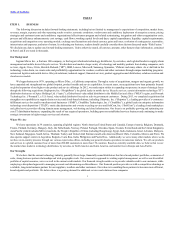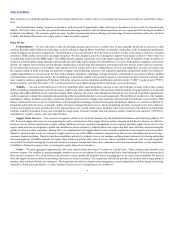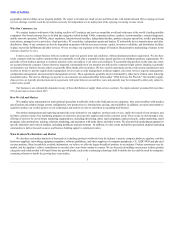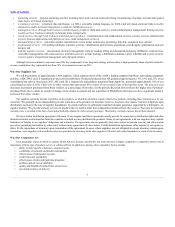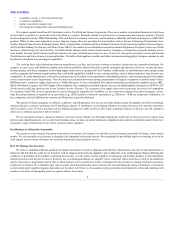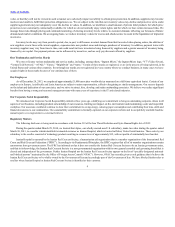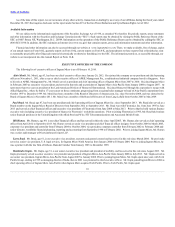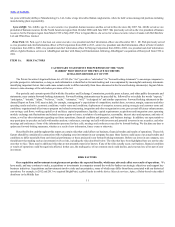Ingram Micro 2013 Annual Report Download - page 13
Download and view the complete annual report
Please find page 13 of the 2013 Ingram Micro annual report below. You can navigate through the pages in the report by either clicking on the pages listed below, or by using the keyword search tool below to find specific information within the annual report.
Table of Contents
to penetrate our network security and misappropriate or compromise our confidential information or that of third parties, create system disruptions or cause
shutdowns. In addition, sophisticated hardware and operating system software and applications that we procure from third parties may contain defects in
design or manufacture, including “bugs” and other problems that could unexpectedly interfere with the operation of the system. The costs to us to eliminate or
alleviate cyber or other security problems, bugs, viruses, worms, malicious software programs and security vulnerabilities could be significant, and our
efforts to address these problems may not be successful and could result in interruptions, delays, cessation of service and loss of existing or potential
customers that may impede our sales, distribution or other critical functions.
We manage and store various proprietary information and sensitive or confidential data relating to our business. In addition, we routinely process, store
and transmit large amounts of data for our partners, including sensitive and personally identifiable information. Breaches of our security measures or the
accidental loss, inadvertent disclosure or unapproved dissemination of proprietary information or sensitive or confidential data about us or our customers,
including the potential loss or disclosure of such information or data as a result of fraud, trickery or other forms of deception, could expose us, our customers
or the individuals affected to a risk of loss or misuse of this information, result in litigation and potential liability for us, damage our brand and reputation or
otherwise harm our business. In addition, the cost and operational consequences of implementing further data protection measures could be significant. Such
breaches, costs and consequences could adversely affect our business, results of operations or cash flows.
Changes in macroeconomic conditions can affect our business and results of operations. Our revenues, profitability, financial position and cash
flows, are highly dependent on the broader movements of the macroeconomic environment. For example, our results of operations have been and continue to be
adversely affected by the difficult conditions experienced in the global economy in recent periods. Economic weakness and uncertainty, including the ongoing
macroeconomic challenges in many countries globally and the debt crisis in certain countries in the European Union, have resulted, and may result in the
future, in decreased revenue, margins and earnings; difficulty managing inventory levels and collecting customer receivables; decreased availability of trade
credit from suppliers or decreased capital availability through debt and similar financing from external parties. In addition, sustained uncertainty about
current global economic conditions, continued negative economic trends or instability, or another recession, may negatively impact our business, leading to:
•reduced demand for products in general;
•more intense competition, which may lead to loss of sales and/or market share;
•reduced prices, and lower gross margin;
•loss of vendor rebates;
•extended payment terms with customers;
•increased bad debt risks;
•shorter payment terms with vendors;
•reduced access to liquidity and higher financing and interest costs;
•increased currency volatility making hedging more expensive and more difficult to obtain; and
•increased inventory losses related to obsolescence and/or excess quantities.
Each of these factors, individually or in the aggregate, could adversely affect our results of operations, financial condition and cash flows. The
economic downturn may also lead us to take additional restructuring actions and reduce associated expenses in response to the lower sales volume. We may not
be able to adequately adjust our cost structure in a timely fashion to remain competitive, which may cause our profitability to suffer.
Our European distribution operations contributed 25% to our net revenue in 2013. The European Union is currently in a prolonged period of economic
uncertainty. Policy disagreement between countries regarding challenges such as fiscal and financial risk sharing have become more pronounced. If a member
nation of the European Union were to default on its national debt, the resulting financial turmoil could disrupt liquidity markets and materially hamper our or
our business partners’ ability to access capital and materially adversely affect our business and financial results. Other income and expense could vary
materially from expectations depending on changes in interest rates, borrowing costs, currency exchange rates, hedging expenses and the fair value of
derivative instruments.
Failure to retain and recruit key personnel would harm our ability to meet key objectives. Because of the nature of our business, which
includes a high volume of transactions, business complexity, wide geographical coverage, and a broad scope of products, suppliers, and customers, we are
highly dependent on our ability to retain the services of our key management, sales, IT, operational, and finance personnel. Our continued success is also
dependent upon our ability to retain and recruit other qualified employees, including highly skilled technical, managerial, and marketing personnel, to meet
our needs. Competition for qualified personnel is intense. We may not be successful in attracting and retaining the personnel we require, which could have a
material adverse effect on our business. In addition, we have, from time to time, reduced our personnel levels in various geographies and functions, in
response to economic, business and other factors, through our restructuring and outsourcing activities. These reductions could negatively impact our
relationships with our workforce, or make hiring other employees more difficult. In addition, failure
13


